My son and I were pruning our macadamia nut tree when his loppers couldn’t cut through a branch. I saw that they were undersized for the branch.
“Don’t force it,” I said. “If it feels like you have to use a lot of strength, it means you need a different tool.”
I gave him a saw. He easily cut through the branch.
I try to follow that advice myself. It really is good advice. And you don’t need a hundred different tools in order to follow it. I find that I do almost all pruning on all of my fruit trees using only three tools. I’ll show you those three, and then I’ll briefly mention some others that I use only in particular situations.
First I’ll show you the tool that I use to cut big stuff because that’s how I prune: cut the big stuff first, and lastly cut any small stuff that’s left.
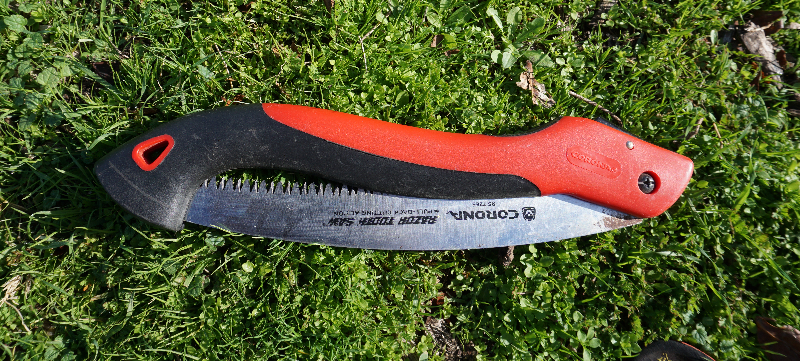
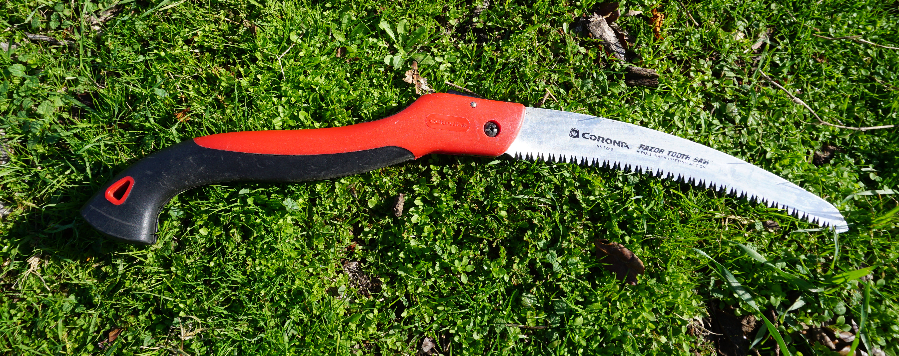
This is a Corona folding saw with a ten-inch blade. I like that it folds so I can easily and safely carry it around. I use it for branches of about six inches thick down to only two inches thick.
Then for branches smaller than that I switch to my loppers.

They are Corona 16-inch loppers. I have bigger loppers, but I find that these small ones are easier to maneuver within a tree canopy and they are also lightweight.
For branches thinner than my pinky finger I use my pruners, especially if the branches are located inside a dense canopy where the loppers can’t be fully opened.
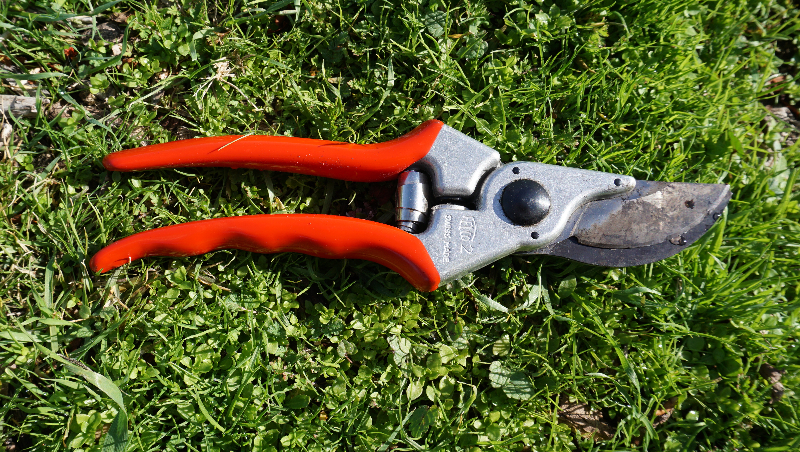
They are Felco 2 pruners (or, “pruning shears”). I’ve owned many other pruners over the years, and some of them also work well, but this pair has shown itself to be built intelligently for effective use and strongly for a long life.
Supplemental tools
Occasionally, I use the following other tools for pruning certain fruit trees.
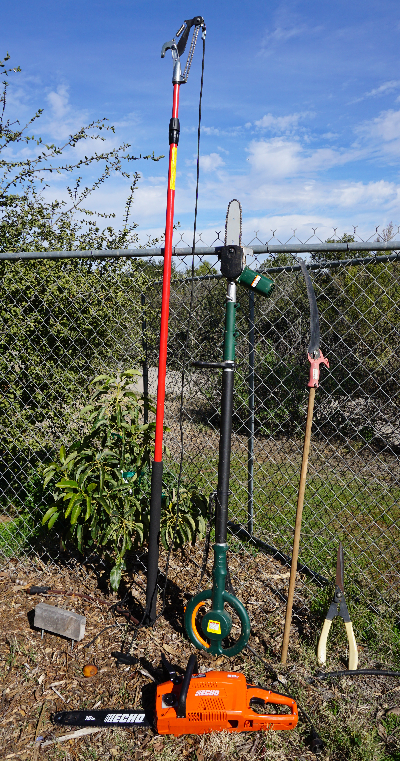
Anything with a pole I only use on my avocados because they are the only fruit trees in my yard that I allow to get taller than my reach (except for one big orange tree). Nevertheless, I use the pole saws infrequently because I usually find it easier to just climb part way up a tree and use my folding saw to remove a high branch.
I use the hedge shears (white handles, far right in photo) for trimming most of my citrus trees, which I keep short like bushes.
And then the chainsaw only comes out when removing an old fruit tree or a large limb that my folding saw can’t handle.
Tool care
To make a pruning cut easy you should use the right tool and also use a clean and sharp tool. I clean my tools after every use with a rag and a wire brush. Every now and again, I spray them down with a lubricant and give them a deep cleaning. About as often, I sharpen them.

It’s a hassle to maintain your tools, but my oh my is it a joy to use a pruning tool that is not sticky and that is sharp.
The other day, when I put the saw into my son’s hand, he fell in love. That was his favorite tool. He could’ve sawed branches all day. But he also enjoyed feeding the branches into our little chipper.
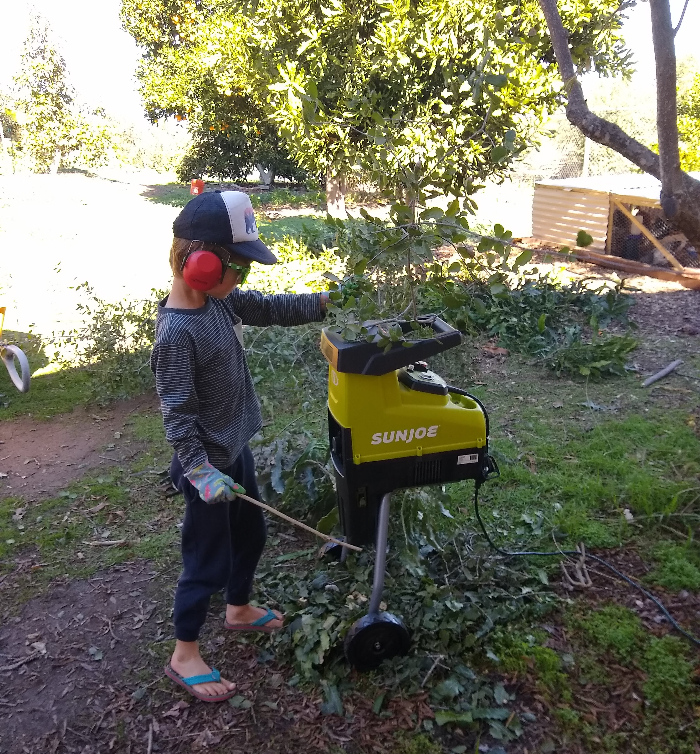
There’s something about pruning work that is perfectly suited for boys. Dismembering and pulverizing stuff — all with dad’s permission.
Even though I don’t think I’ll ever get the thrill out of pruning and chipping that my son does, using the right tools that have been maintained makes the work pretty fun.
All of my Yard Posts are listed HERE
Gardeners like you support my Yard Posts, which is why I don’t have to fill this page with ads. Thank you.




Felco hand pruners are expensive but worth it. Corona saws are awesome, pruning shears not so much. I got some loppers with twist and extend handles, increasing the leverage mightily. If you circumcise a branch by moving pruners or loppers around in a circular motion, it’s surprising what you can beaver off. I sharpen blades with very fine sandpaper and clean with WD-40 after use.
Thanks, Randy. Never tried sandpaper for sharpening. I’ll check that out.
I have a very mature Macadamia tree, too. It has monster crops, but I no longer get to eat any of the nuts. The ground squirrels eat them all long before they are even ripe. I may down the tree because of the loss making it not worth the mess under the tree each year. I guess it depends on whether I can lure a barn owl to the nest box I’m near ready to stand up on its post.
I as well have a mature Macadamia tree and tried something new this year. Mixed Tobacco with water and very little soap which kept the little critters off the tree for a few weeks. After that they eventually cleared me out in a heart beat. The spraying took time and only tried it one time. In the past before the squirrel issue I and my kids always looked forward to harvesting the delicious nuts. Possible I will get on a routine of spraying next year. Next year will be planting 40 avocado sleeve trees, Gems and Reeds. Will make sure the squirrels don’t touch the fruit and will spray all the trees all at once while fruiting. Been living here for over 40yrs. until recently having a squirrel issue. If anyone can help with the squirrel population please post a comment!
Thank You
Joe
Hi Joe,
Two options to consider are bate (Wilco squirrel bate) which some people don’t like for a number of reasons (i use it when things get out of hand one year), and bird netting. The netting should be only loosely draped around the base of the tree, not tight against the trunk where the squirrels usually path upwards into the tree. On certain trees I unfurl it near ripeness time and roll it back up once the crop is in. On occasion it’s even caught a few rattlesnakes. Squirrels especially can get out of control quickly in a single year it seems. We have coyotes around us, so that helps somewhat as well.
Joe
Hi David and Joe,
Squirrels love macadamia nuts, that’s for sure. See my post on squirrels, where I note that my grandmother also has an old macadamia tree whose nuts mostly go to the squirrels: https://gregalder.com/yardposts/dealing-with-squirrels-in-a-food-garden/
I have a buddy that loves that the squirrels eats the nuts from his macademia nut tree. Ever since it started giving nuts, it keeps them away from his avocados which he now gets to eat 🙂
I have 10 Avocado trees now and I have all of the trees mulched. When I fertilize the trees can I spread the fertilizer on the top of the mulch or should I move the mulch back so the fertilizer is in the dirt?
Hi Gerry,
It’s probably unnecessary to move the mulch. I just add the fertilizer on top and then by hand or with a rake, mix the fertilizer into the mulch a bit.
Be sure to apply the fertilizer wherever the irrigation water goes. If the trees are watered with sprinklers, then after applying the fertilizer you can give the sprinklers a run to incorporate the fertilizer down through the mulch. If the trees are on drip, you should make sure the fertilizer is under the emitters so their water will take it down into the soil; or else you can spray it down with a hose.
I am looking to buy a lemon and an avocado tree. Can anyone recommend a good source. I am located in Pasadena.
San Gabriel Nursery and Mimosa Nursery are not far from Pasadena and worth a visit. Was at San Gabriel this week and they had several types of Avocados. But they weren’t selling citrus due to some kind of blight.
What about sanitizing between trees to avoid spread of disease?
Hi Dana,
I don’t do anything to try to sanitize my tools between pruning my fruit trees.
This is for a couple reasons. One, I almost never use my tools on trees outside of my yard.
Two, there are surprisingly few studies that show that pruning tools do spread many diseases from tree to tree. It’s usually an assumption that is repeated by people without evidence ever being offered.
Maybe it’s true, maybe it’s not. But I don’t find much evidence that it is true. For example, a study on spreading fire blight among pear trees with pruning tools found that it never happened during winter pruning and only sometimes happened during summer pruning. See “Risk of fire blight infection associated with pruning of pear trees” by P. Lecomte: https://pdfs.semanticscholar.org/e03f/b64f140bbe8e395dcbec85b8aedd73dde95c.pdf?_ga=2.187745960.1029863891.1672072555-1295522917.1671602616
Moreover, in this study they were purposefully cutting into branches with fire blight symptoms (“fresh lesions”). But if you know how to prune a tree with fire blight symptoms, then you would never cut into the infected part of the branch anyway; you would cut well below the infected part. Therefore, it seems unlikely for fire blight to ever be spread by pruning tools if the pruner is doing the job correctly.
Three, I can’t find evidence that attempting to sanitize tools with chemical solutions is effective in real world conditions. The evidence that I’ve seen comes from lab work done on tools like scalpels whereas when actual pruning shears are used the same disinfectants don’t get the same results. For example, see “Disinfection of pruning shears for the prevention of the fire blight transmission” by Kleinhempel: https://www.actahort.org/books/217/217_35.htm
If I were travelling around using my tools to prune other people’s trees all the time, then maybe I would try to sanitize my tools with chemicals just because it might help. If I were pruning a monoculture (say, a grove of a thousand citrus trees), then I might try to sanitize tools, especially if I saw disease symptoms in a tree.
But because of my situation of having a home orchard of different types of trees that don’t share many diseases, and rarely using my tools outside of my own yard, and because of my current knowledge of the evidence, I do nothing to attempt to sanitize my pruning tools.
Greg, I love those Felcos! And need a new pair. You were pruning your macadamias but didn’t leave a video on it!! Are you planning to? I’ll stay tuned…
Hi Cathy,
I was just cutting off some lower branches so my chickens couldn’t get up into the tree to roost anymore. They are always trying to roost in that macadamia tree when it’s time for me to get them into their coop for the night.
But I have been thinking that I ought to do a video on some aspect of pruning. Please let me know if you have ideas.
Greg, I love chickens!! Do you actually eat them after their egg-laying years are over? I couldn’t get past the “we don’t eat our pets” thing I’ve got going. They can reach 12 years old if the coyotes, hawks or cancer doesn’t get them. How do you do it?
Hi Cathy,
We had always planned on eating old hens or roosters that we didn’t want (because they’re aggressive, for example), but have not gotten around to it. Either a predator gets to them before we do or something else gets in the way.
It’s a bit more difficult to eat the birds if you have few and you or the kids have named them. They are like pets then. That’s been our situation until recently. We now have around twenty hens and I’m guessing we’ll possibly, eventually eat one in the next few years.
With the chickens that have died in other ways, if we have a carcass to deal with, we have buried it beside a fruit tree which will give the tree some fertility as it decomposes.